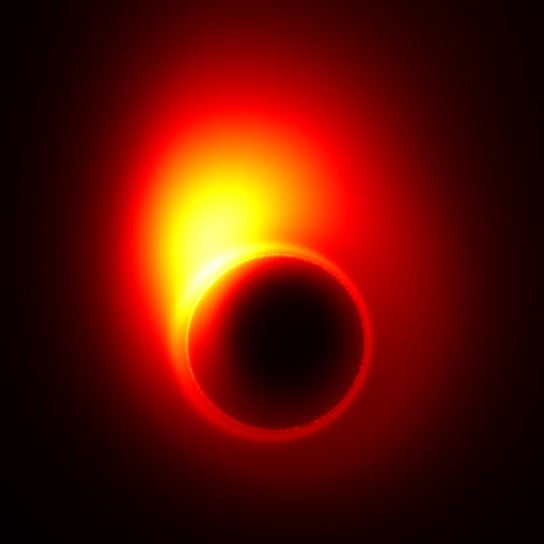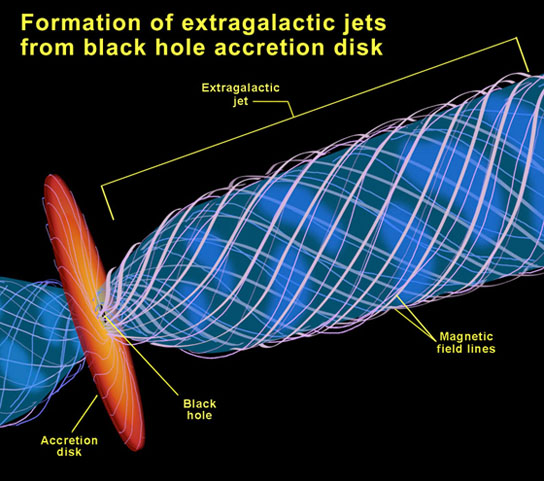
This image, created using computer models, shows how the extreme gravity of the black hole in M87 distorts the appearance of the jet near the event horizon. Part of the radiation from the jet is bent by gravity into a ring that is known as the ‘shadow’ of the black hole. Credit: Avery E. Broderick (Perimeter Institute & University of Waterloo)
Using the Event Horizon Telescope, an international team of scientists has for the first time measured the radius of a black hole at the center of M87, a galaxy some 50 million light years from the Milky Way.
The point of no return: In astronomy, it’s known as a black hole — a region in space where the pull of gravity is so strong that nothing, not even light, can escape. Black holes that can be billions of times more massive than our sun may reside at the heart of most galaxies. Such supermassive black holes are so powerful that activity at their boundaries can ripple throughout their host galaxies.
Now, an international team, led by researchers at MIT’s Haystack Observatory, has for the first time measured the radius of a black hole at the center of a distant galaxy— the closest distance at which matter can approach before being irretrievably pulled into the black hole.
The scientists linked together radio dishes in Hawaii, Arizona, and California to create a telescope array called the “Event Horizon Telescope” (EHT) that can see details 2,000 times finer than what’s visible to the Hubble Space Telescope. These radio dishes were trained on M87, a galaxy some 50 million light years from the Milky Way. M87 harbors a black hole 6 billion times more massive than our sun; using this array, the team observed the glow of matter near the edge of this black hole — a region known as the “event horizon.”
“Once objects fall through the event horizon, they’re lost forever,” says Shep Doeleman, assistant director at the MIT Haystack Observatory and research associate at the Smithsonian Astrophysical Observatory. “It’s an exit door from our universe. You walk through that door, you’re not coming back.”
Doeleman and his colleagues have published the results of their study this week in the journal Science. The study states that, “the derived size of 5.5 ± 0.4 Schwarzschild radii is significantly smaller than the innermost edge of a retrograde accretion disk, suggesting that the M87 jet is powered by an accretion disk in a prograde orbit around a spinning black hole.”
Jets at the edge of a black hole
Supermassive black holes are the most extreme objects predicted by Albert Einstein’s theory of gravity — where, according to Doeleman, “gravity completely goes haywire and crushes an enormous mass into an incredibly close space.” At the edge of a black hole, the gravitational force is so strong that it pulls in everything from its surroundings. However, not everything can cross the event horizon to squeeze into a black hole. The result is a “cosmic traffic jam” in which gas and dust build up, creating a flat pancake of matter known as an accretion disk. This disk of matter orbits the black hole at nearly the speed of light, feeding the black hole a steady diet of superheated material. Over time, this disk can cause the black hole to spin in the same direction as the orbiting material.

An accretion disk (orange) of gas and dust surrounds super-massive black holes at the center of most galaxies. These disks of galactic matter emit magnetic beams (pink lines) that spew out from the center of the black hole, drawing matter out from both ends in high-powered jets. Credit: NASA and Ann Field (Space Telescope Science Institute)
Caught up in this spiraling flow are magnetic fields, which accelerate hot material along powerful beams above the accretion disk The resulting high-speed jet, launched by the black hole and the disk, shoots out across the galaxy, extending for hundreds of thousands of light-years. These jets can influence many galactic processes, including how fast stars form.
‘Is Einstein right?’
A jet’s trajectory may help scientists understand the dynamics of black holes in the region where their gravity is the dominant force. Doeleman says such an extreme environment is perfect for confirming Einstein’s theory of general relativity — today’s definitive description of gravitation.
“Einstein’s theories have been verified in low-gravitational field cases, like on Earth or in the solar system,” Doeleman says. “But they have not been verified precisely in the only place in the universe where Einstein’s theories might break down — which is right at the edge of a black hole.”
According to Einstein’s theory, a black hole’s mass and its spin determine how closely material can orbit before becoming unstable and falling in toward the event horizon. Because M87’s jet is magnetically launched from this smallest orbit, astronomers can estimate the black hole’s spin through careful measurement of the jet’s size as it leaves the black hole. Until now, no telescope has had the magnifying power required for this kind of observation.
“We are now in a position to ask the question, ‘Is Einstein right?’” Doeleman says. “We can identify features and signatures predicted by his theories, in this very strong gravitational field.”
The team used a technique called Very Long Baseline Interferometry, or VLBI, which links data from radio dishes located thousands of miles apart. Signals from the various dishes, taken together, create a “virtual telescope” with the resolving power of a single telescope as big as the space between the disparate dishes. The technique enables scientists to view extremely precise details in faraway galaxies.
Using the technique, Doeleman and his team measured the innermost orbit of the accretion disk to be only 5.5 times the size of the black hole event horizon. According to the laws of physics, this size suggests that the accretion disk is spinning in the same direction as the black hole — the first direct observation to confirm theories of how black holes power jets from the centers of galaxies.
The team plans to expand its telescope array, adding radio dishes in Chile, Europe, Mexico, Greenland, and Antarctica, in order to obtain even more detailed pictures of black holes in the future.
Christopher Reynolds, a professor of astronomy at the University of Maryland, says the group’s results provide the first observational data that will help scientists understand how a black hole’s jets behave.
“The basic nature of jets is still mysterious,” Reynolds says. “Many astrophysicists suspect that jets are powered by black hole spin … but right now, these ideas are still entirely in the realm of theory. This measurement is the first step in putting these ideas on a firm observational basis.”
Reference: “Jet-Launching Structure Resolved Near the Supermassive Black Hole in M87” by Sheperd S. Doeleman, Vincent L. Fish, David E. Schenck, Christopher Beaudoin, Ray Blundell, Geoffrey C. Bower, Avery E. Broderick, Richard Chamberlin, Robert Freund, Per Friberg, Mark A. Gurwell, Paul T. P. Ho, Mareki Honma, Makoto Inoue, Thomas P. Krichbaum, James Lamb, Abraham Loeb, Colin Lonsdale, Daniel P. Marrone, James M. Moran, Tomoaki Oyama, Richard Plambeck, Rurik A. Primiani, Alan E. E. Rogers, Daniel L. Smythe, Jason SooHoo, Peter Strittmatter, Remo P. J. Tilanus, Michael Titus, Jonathan Weintroub, Melvyn Wright, Ken H. Young and Lucy M. Ziurys, 27 September 2012, Science.
DOI: 10.1126/science.1224768
This research was supported by the National Science Foundation.









So, how big is it? You have estimated the mass but is the black hole itself the size of my thumb or the size of our solar system?
Forgive me for not understanding what 5.5 ± 0.4 Schwarzschild radii means. Was
Schwarzschild a rotound individual and we multiply his girth by pi squared?
The headline of the article was “Scientists Measure the Radius of a Black Hole at the Center of M87” How big is it?
Schwarzschild Radius is wellknown formula in Physics, and it is 2*G*M/c^2 for the size of the black hole, where G is the gravitation constant, M is the mass and c is the speed of light in vacuum. Speed of light and gravitation constant are constants, so we can determine ”radius” of a black hole by its mass.
Now to your question, is it tiny or large? Digging that mass from the internet, and with an iPhone calculator you get 11 to 18 billion miles radius (depending on what source you trust for the mass). That is alot, definitely not your thumb size, rather you could fit our entire solar system inside that black hole because the orbital radius of Pluto is ”just” 3.7 billion miles.
When matter pours in to the black hole, it forms gradually a rotating disk around the black hole. Gravitational tidal forces pull the matter to that equatorial disk. The same happens to Earth satellites, but less violently. That 5.5+/-0.4 Schwartzschild radii was the rotation disk inner radius. It is five and half times larger than the Schwarzschild radius. Due to distance, they cannot measure it accurately (billions and billions miles away), so they estime it to vary between 5.1 to 5.9 times the radius. The disk does not touch the black hole, so those jets must come from the rotation disk.
Please note, we do not know how big the black hole really is. That Schwartzschild radius is the outer barrier of the black hole. Laws of Physics known to mankind do not adequately explain what is the world like inside a black hole. Is there a smaller nucleus, some unknown force ending the compression, or is it a tunnel to other worlds or universum, or is matter scrambled to an entirely new form, already when passing over that barrier of no return.
Every galaxy has a black hole at the centre being its core. The fact that extragalactic jet emanates from it and accretion disc is close to its core as viewed in the subject gives a strong doubt that spewing of jets are propelled by some bits of dark matter encapsuled in its core. For the same reason accretion disc which is just only 5.5 times the basic radius of the core denotes that the entire mass of the crumbling stars are stopped at a distance close to its core and thus they are gravitationally locked to spin at the same speed of the central core of black hole. No more sinking of the matter or light is allowed. Instead the compressed mass around its core in the innermost orbit is sucked and driven back by some anti-gravitational force (probably of the inner core of dark matter bits) as high speed jets magnetic field lines with the speed comparable to the speed of light by such very powerful force from black holes. Black holes are always a mystery to be probed thoroughly. Thank You.
Blackhole actual radius should be ~0.75 LY @Troy Lund (or roughly 13x the size of the solar system).
Prev answer incorrect. Schwarzschild radius for this mass (~6.5E9 solar masses) is 0.0019 light year = ~0.7 light days, = ~125 * earth radius around sun (Check Wikipedia or other for reference). One observes the diameter though = 2*radius. distance is ~54M L.Y., so diameter in radian terms, viewed from earth, is (2*0.0019)/(55,000,000) = ~ 0.7E-9 (!!!)
The so-called black hole of M87 is only an artifact due to data sampling bias. See this recent research paper (The jet and resolved features of the central supermassive black hole of M87 observed with EHT”, May 20, 2022. https://arxiv.org/pdf/2205.04623.pdf). I completely agree given the total absence of any direct proof for the physical existence of ANY black hole. Conceptually black hole is a nonsense